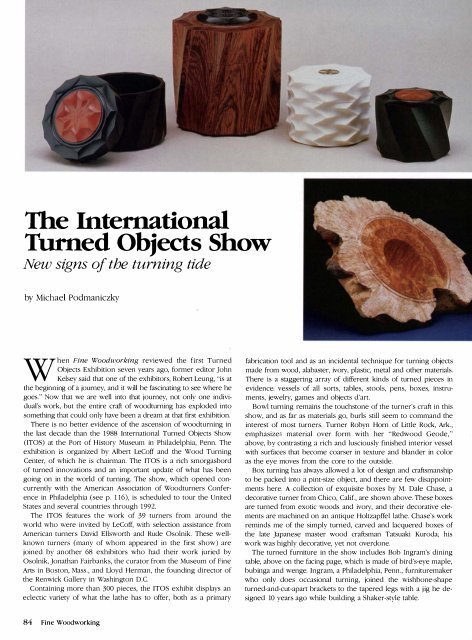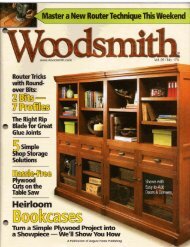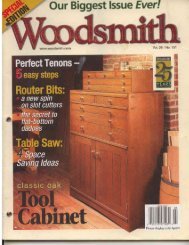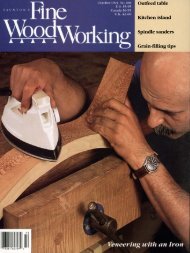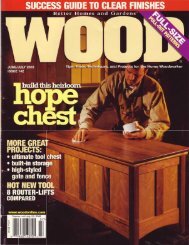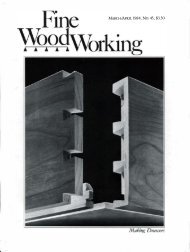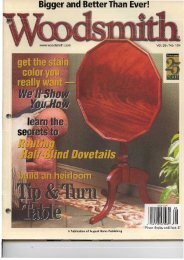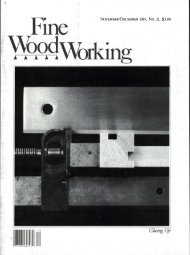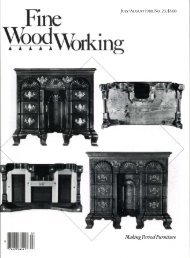The Inte rnationalT urned Objects ShowNew signs of the turning tideby Michael PodmaniczkyWhen Fine Woodworking reviewed the first TurnedObjects Exhibition seven years ago, former editor JohnKelsey said that one of dle exhibitors, Robert Leung, "is atthe beginning of a journey, and it will be fascinating to see where hegoes." Now that we are well into that journey, not only one individual'swork, but the entire craft of woodrurning has exploded intosomething that could only have been a dream at dlat first exhibition.There is no better evidence of dle ascension of woodturning inthe last decade than dle 1988 International Turned Objects Show(ITOS) at the Port of History Museum in Philadelphia, Penn. Theexhibition is organized by Albert LeCoff and the Wood TurningCenter, of which he is chairman. The ITOS is a rich smorgasbordof turned innovations and an important update of what has beengoing on in the world of turning. The show, which opened concurrentlywilli the American Association of Woodturners Conferencein Philadelphia (see p. 116), is scheduled to tour the UnitedStates and several countries through 1992.The ITOS features the work of 39 turners from around theworld who were invited by LeCoff, with selection assistance fromAmerican turners David Ellsworth and Rude Osolnik. These wellknownturners (many of whom appeared in the first show) arejoined by another 68 exhibitors who had their work juried byOsolnik, Jonathan Fairbanks, the curator from the Museum of FineArts in Boston, Mass., and Lloyd Herman, the founding director ofthe Renwick Gallery in Washington D.C.Containing more than 300 pieces, the ITOS exhibit displays aneclectic variery of what the lathe has to offer, bodl as a primaryfabrication tool and as an incidental technique for turning objectsmade from wood, alabaster, ivory, plastiC, metal and other materials.There is a staggering array of different kinds of turned pieces inevidence: vessels of all sorts, tables, stools, pens, boxes, instruments,jewelry, games and objects d'art.Bowl turning remains the touchstone of the turner's craft in thisshow, and as far as materials go, burls still seem to command theinterest of most turners. Turner Robyn Horn of Little Rock, Ark.,emphasize material over form with her "Redwood Geode,"above, by contrasting a rich and lusciously finished interior vesselwith surfaces that become coarser in texture and blander in coloras the eye moves from the core to the outside.Box turning has always allowed a lot of design and craftsmanshipto be packed into a pint-size object, and dlere are few disappointmentshere. A collection of exquisite boxes by M. Dale Chase, adecorative turner from Chico, Calif., are shown above. These boxesare turned from exotic woods and ivory, and their decorative elementsare machined on an antique Holtzapffel ladle. Chase's workreminds me of the simply turned, carved and lacquered boxes ofthe late Japanese master wood craftsman Tatsuaki Kuroda; hiswork was highly decorative, yet not overdone.The turned furniture in the show includes Bob Ingram's diningtable, above on the facing page, which is made of bird's-eye maple,bubinga and wenge. Ingram, a Philadelphia, Penn., furnituremakerwho only does occasional turning, joined the wishbone-shaperurned-and-cut-apart brackets to the tapered legs with a jig he designed10 years ago while building a Shaker-sryle table.84 Fine Woodworking
Using a Holtzapffel ornamental lathe tocut the fa ceted designs, M. Dale Chasemakes small boxes from many exotic materials,including these, left made of Hondurasrosewood, pink ivory wood, African blackwoodand ivory. Robyn Horn's 'RedwoodGeode, ' below left, allows the exterior ofthe burl to remain naturally rough, incounterpoint to the finished vessel turnedon the inside. Bob Ingram turned a 48-in. dia. disc Of bird's-eye maple for the topof his post-and-bracket-style dining table,below. The tapered legs are turned bubinga.After turning a simple ebony vessel, right,Frank E. Cummings III inlaid two bands ofivory with 14K-gold accents. He thencarved a delicate openwork pattern aroundthe top, allowing it to distort and create alace-like effect.One of the loveliest objects in the exhibition is by Frank E.Cummings III of Long Beach, Calif., who produced a cup of arrestingbeauty he calls "Ebony Lace," shown above, right. This is a stemlesscup that flows into a remarkable band of wavy, lacy carvingaround the lip. Around the base and lip, Cummings applied bandsof ivory, overlaid by a balustrade of fine gold rods. The bandsbreak up the flow of figure within the Macassar ebony, but thecoloration is so strong that the eye cannot help being drawn upfrom the solid turning into the delicately carved fretwork.Despite the kaleidoscopic range of styles and aesthetics in theITOS, one turner's work appeals directly to my tastes. The architecturalturnings of Gail Redman, right, embody all the truths of theturners u-ade: the simplicity and beauty of wood are unadulterated bya finish of any kind. 111e results of cutting edge on wood are leftnaked for inspection. And, the spongy, truculent redwood the SanFrancisco, Calif., turner chose maintains sharp, crisp corners and surfaces,and it bears not me slightest blemish of catch or tearout or anyhint of an unsure hand. What is on display is noming less man completemastery of a craft:. To me, mis is what turning is all about. DArchitectural turner Gail Redman 's turned balustradeand newel post, below, shows the criSpand clear tool marks of a deft touch, difficult inthe soft redwood she used to make the turnings.Michael Podmaniczky is a contributing editor to FWW and a furnitureconservator at The Winterthur Museum in Winterthur, Del.For ITOS schedule information, contact the International SculptureCenter, 1050 Potomac St. NW, Washington, D.c. 20007. TheITOS catalog, with pictures of all the exhibit pieces, is availablefrom the Wood Turning Center, Box 25706, Philadelphia, Penn.19144, /01' $32 ppd. (sojtcover) or $43 ppd. (hardcover).Photos: (>1988 Eric MitchellJanuary/February 1989 85
- Page 3 and 4:
FineW> rktng'_' ______ ___ January/
- Page 6 and 7:
Letters (contillued)never hurt hims
- Page 8 and 9:
MetiJods of Wo rkedited and drawn b
- Page 10 and 11:
Methods of Wo rk (contillued)exampl
- Page 12 and 13:
Making a door sandwichI intend to m
- Page 14 and 15:
Q & A (colltillued)of a bad situati
- Page 16 and 17:
Pollou'-upby Dick BurrowsMore on to
- Page 18 and 19:
Easy toStep by Step DrawingsBuildOn
- Page 20 and 21:
(25 years)P-SOO20" PlANERSEATTLE:1
- Page 22 and 23:
There areover 4,000money-savingreas
- Page 24 and 25:
READY TO ASSEMBLE-SOLID-CHERRYWALNU
- Page 26 and 27:
THE BARTLEYBUNDLES!AlJ.500 ·24"Ban
- Page 28 and 29:
A GREAT DEA.L IMORE (f)5 HP, 3 Ph3
- Page 30 and 31:
--ANTIQUE & USED TOOLSQuality, olde
- Page 32 and 33:
PhoneStater--- - -[][]Ur:iTheWoodwo
- Page 34 and 35: """""',' Universal Precision Measu
- Page 36 and 37: FineWorking January/February 1989M
- Page 38 and 39: Once the backrest plaques are joine
- Page 41 and 42: Fig. 4:.1:iim.lf1lmllli.iiiiie?tII
- Page 43 and 44: Secret compartments were so common
- Page 45 and 46: -----.JFig. 4: Hanging tray below t
- Page 47 and 48: Tbree examples of the author's slid
- Page 49 and 50: worked but will maintain a crisp, s
- Page 53 and 54: SCROLL-SA W TESTCompany and model L
- Page 55 and 56: An ordinary woodturning lathe can b
- Page 57 and 58: use a dust collector, and if possib
- Page 59 and 60: I've never been especially fond of
- Page 61 and 62: and it shields your fingers from ex
- Page 63 and 64: The cabinet scraper used by the aut
- Page 65 and 66: Fig. 2: Post:Modern Table Top, 52 i
- Page 67 and 68: Fig. 3: LFI TableNut is fastened to
- Page 69 and 70: Fig. 3: Curved miterPattern doesn't
- Page 71 and 72: Selections from the author's sketch
- Page 73 and 74: thor anticipate problems and make f
- Page 75 and 76: Fig. 2: Air flowMoist air exits thr
- Page 77 and 78: lating fan. The idea here is to ins
- Page 79 and 80: Long prized by woodworkers for its
- Page 81 and 82: A Chinese woodworker assembles an e
- Page 83: Chinese shaping toolsThroughout Chi
- Page 87 and 88: NOW! BUY BRIDGEWOOD IN CANADA . ..
- Page 89: QiUl j!! IIIc:Ul.=:c ...!!
- Page 92 and 93: 111,"11SIOPm'EI.I,lu it ....IS •
- Page 94 and 95: CARBIDE TIPPED ROUTER BITSPRCAL PRO
- Page 96: FS Tool CorporationP.o. Box 510, 21
- Page 99 and 100: ... !Ij*;::""' eMore NTS 14-5614" H
- Page 101 and 102: FI:\ISHI:\G SLPPLIESIf you have bee
- Page 103 and 104: T\UNTONPUBliCATIONS... by fellow en
- Page 105 and 106: PmeWqqQWorkingIndex to issues 66 th
- Page 107 and 108: FowlerFowler, Brian, chair by, 67,1
- Page 109 and 110: ScrewsZimmerScrews:brace driving of
- Page 111 and 112: 34-76 1 10' Uni s-l-l/2 hp ........
- Page 113 and 114: MOISTURE METERFAMOUS "MINI-LiGNO"MA
- Page 115 and 116: Dependable extra hands for all type
- Page 117 and 118: MIRRORA· THE HAND MIRRORCOMPLEMENT
- Page 119 and 120: £'Delrl.lnc'e To Manufacture Quali


